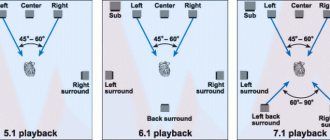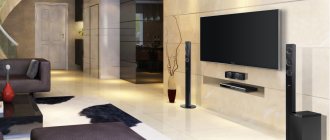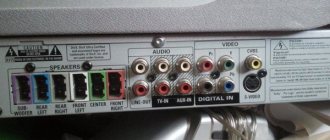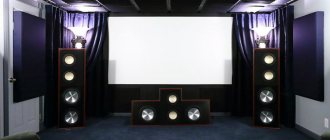Delay
Streaming audio has long been transmitted via Bluetooth and Wi-Fi, but certain rough edges remain.
In particular, these data transmission standards do not have very high noise immunity, and the range and capacity of current Bluetooth options are not at all suitable for multi-channel audio. But the main thing is the delay that devices based on these technologies demonstrate, the so-called “latency” - the delay time between the input and output signal (sound). If you play only music, you don’t have to think about this parameter. With video it’s a different matter. Latency is the enemy of lip sync (literally - lip synchronization), the exact correspondence of the sound to what is happening on the screen. In other words, imagine that you are watching a movie in which something explodes on the screen, as expected, raising a column of smoke and fire, the characters spectacularly scatter under the influence of a blast wave... and only at that moment a powerful sound of an explosion is heard. This is no good. To be fair, we note some successes in the fight against latency, for example, in Bluetooth audio technology.
Wireless home theater
Wireless signal transmission methods are far from new: they existed 15-20 years ago. This technology has been used in professional concert equipment, such as radio microphones and electric guitars. Then wireless technologies stepped into the world of amateur audio systems. The acoustic signal in modern home theaters is transmitted wirelessly:
- via Bluetooth;
- using a Wi-Fi transmitter;
- radio waves
Who is behind WiSA
Research and attempts to create a standard for high-quality sound transmission in a recreation center have been going on for a long time. Judging by the latest news, we can say that the WiSA Ready platform, which is actively promoted by Summit Wireless Technologies, Inc and the WiSA (Wireless Speaker and Audio Association) association of the same name, has become a leader. Summit Wireless, formerly Summit Semiconductor, Inc., is headquartered in San Jose, California, with sales offices in Taiwan, China, Japan and Korea.
If you count the logos on the website, then about thirty declared members have already joined WiSA. In 2021, up to 60 million WiSA Ready products will be on the market. Right now, WiSA is already available in select models of LG Electronics TVs (while setting the “protection” parameters in the software of the TV that supports this technology), Xbox consoles and active speakers from nine premium speaker manufacturers, in particular, the Klipsch Reference speakers demonstrated there . Work is underway to certify WiSA Ready for all new devices.
Receive audio files via Bluetooth
Outputting sound files from a smartphone, laptop or tablet follows the same principle:
- Audio files from a mobile device, which also has a Bluetooth chip, are transferred to the receiver.
- The signal is decoded, divided into channels, then branched.
- Some channels are sent to the amplifier and then to the front and center speakers using wired technology.
- The other part of the channels is recoded and distributed to the rear active speakers, where they are received, decoded again, amplified and broadcast. Sound volume commands and delay time are also transmitted to these same speakers to implement spatial sound.
Home theater model Sony BDV-N9100W with Blu-Ray and 5.1 system. has excellent sound. The total acoustic power is 1000 W. Sound can be output to the speakers from any mobile device using the Bluetooth module. The rear speakers are wireless; they are connected to a separate amplifier; there is no need to run wires across the room.
Minus receiver
“WiSA is quickly becoming the new de facto standard in wireless immersive audio,” the association wrote in a press release. Now it’s difficult to say how quickly, but as a fact, this technology claims to be a new standard and may well be successful. After all, she proposes to replace the home theater set in the format “TV/projector + AV receiver + set of acoustics” with a compact combination of the type “TV/projector + set of active acoustics”. As a result, the user will get rid of a bulky AV receiver and a bundle of speaker cables.
All speakers, like the subwoofer, are, of course, active; they receive the signal from a small central WiSA unit via wireless communication (and we wrote above that there are already options built directly into the TV), the acoustics only require power. But for many people, plugging a plug into the nearest outlet is easier than pulling an acoustic cable across the room to an AV receiver located somewhere near the front wall.
In addition, not just a home theater - in an interview with Sound&Vision, WiSA Association President Tony Ostrom Fr.
Advantages and disadvantages
The positive thing is that installing wireless speakers is much faster and easier than wired analogues, due to the absence of connection cables. This is convenient when more than 10 speakers are connected.
Negative factors include the difficulty of creating the necessary environment for the highest quality sound. The clarity and level of sound depend on the size of the room and the correct placement of the speaker system. The columns are placed at the same distance from each other.
And also, the disadvantages include installing sockets near each speaker. They create a small electromagnetic pulse, thereby reducing the sensitivity of the equipment to interference. In addition, the systems are sensitive to microwaves and begin to hiss and make noise.
How WiSA works
Products with the WiSA Ready logo, combined with a WiSA USB dongle and WiSA certified speakers, by modern standards, provide quite high-quality (at the presentation held as part of CES it was called “the highest possible”) wireless sound for movies, music, games (e-sports) and other modern audio options.
Summit Wireless Technologies does not publish detailed information about what exactly WiSA technology is, but there is some information available. Five years ago, the WiSA Association published data on the capabilities of the technology. In particular, the document talked about wireless transmission of 24-bit uncompressed audio with a resolution of up to 96 bits/sec and rapid error detection and recovery, using algorithms similar to those used in CD playback technology and providing continuous sound. It is known that the WiSA system implements the transmission of uncompressed audio at a frequency of 5.2–5.8 GHz. The company also writes that it will be possible to transmit up to 8 channels of uncompressed 24-bit audio, including immersive formats such as Dolby Atmos and DTS X. The most important thing is that the delay is the same “latency” - only 5.2 ms, and it is not varies depending on network load (this is 10-20 times better than Bluetooth and Wi-Fi). Moreover, the same Tony Ostrom notes that the delay can be reduced to 2.6 ms, and synchronization between all speakers occurs with a deviation of no more than two microseconds.
In addition, ADAPT algorithms (a Summit Wireless Technologies patent), according to WiSA specialists, somehow prevent interference, prioritize traffic and thereby double the throughput of the wireless network. This is true also for a full set of 7.1 speakers, and for Atmos configurations up to 5.1.2.
In addition, the WiSA-compatible audio stream transmission option fully meets the requirements of DFS, which provides it with increased noise immunity.
TOP 20 rating of home theaters 2021.
- TOP 20 rating of home theaters 2021. 1. LG BH9540TW
- 2. Samsung HT-F9750W
- 3. Onkyo HT-S7705
- 4. Sony BDV-E6100
- 5. Sony DAV-DZ650
- 6. 3D Pioneer MCS-737
- 7.BBK DK1114Si
- 8. Philips HTB 3520G
- 9. LG LHB755
- 10. Sony DAV-TZ140
- 11.Yamaha BDX-610
- 12. Philips HTB7590KD
- 13. Sony BDV-E4100
- 14. Sony BDV-N9200W
- 15. Harman/Kardon BDS 880
- 16. Panasonic SC-HTB520
- 17. Sony BDV-E370
- 18. LG HB805PH
- 19. Mystery MSB-115W
- 20. Samsung HT-J4550K
LG BH9540TW
BUY
The first place in our review is deservedly occupied by a good home theater, the quality and capabilities of which fully meet the requirements of the most picky buyers.
This model is famous for its built-in memory of 1 GB, the ability to play any format, as well as quick startup and readiness for use.
In addition, quite often owners note in reviews the sound output through a telephone headset. In addition to the advantages, the cinema also has disadvantages: in some modes
Smart TV has a bit of crackling in the speakers, noticeably blurred bass and occasional oversaturation of tones.
Samsung HT-F9750W
The second place is occupied by an acoustic system with 7 channels and 3D format. This is an inexpensive home theater.
The main advantages of this option are: a cascade power amplifier, fine-tuning the sound through internal elements, wireless rear speakers, and a fairly powerful subwoofer.
In addition, owners are enthusiastic about the presence of such functions as Smart Hub and Smart TV.
As disadvantages, people note the lack of dialog boxes, which are sometimes necessary, as well as the reduced functionality of the audio equalizer.
Onkyo HT-S7705
Bronze deservedly goes to a cinema with excellent functionality, made in Japan, which allows it to stand out for its quality and appearance.
The advantages of this equipment include the ability to wirelessly connect to a network, easy control and settings, high quality sound and image due to good decoders.
Speaking about the negative aspects, users most often highlight the not very strong rear speakers.
Sony BDV-E6100
The popular model, to which you can easily connect a computer hard drive and a smartphone or tablet, has both wireless and wired connections to networks.
This home theater is famous for its speakers, which produce clear sound, without rattling or unnecessary vibrations.
The only drawback is the difficulty in control, which only an experienced user can quickly get used to, but a beginner will need to frequently refer to the instructions at first.
Sony DAV-DZ650
One of the budget models is equipped with fewer functions, although this does not prevent it from working fully and pleasing its owners.
The main advantages include clear and high-quality sound, excellent image, quick setup, and ease of operation.
Among the shortcomings, people note, as a rule, the lack of support for the Cyrillic alphabet, but its automatic conversion into individual characters.
3D Pioneer MCS-737
This option is initially designed for increased picture quality rather than sound quality, which is important to consider when considering a cinema.
In general, this device is quite functional and of high quality, since the speakers operate with a power of 1000 W, users respond positively to the bass, and there are no problems during setup.
In addition, a significant advantage is the ability to read all formats.
BBK DK1114Si
A simple cinema for small houses is famous for its modern external design and the ability to work with discs.
It allows the user to listen to up to 20 radio stations.
The only drawback is the inability to view three-dimensional images.
Philips HTB 3520G
A real find for connoisseurs of pure sound, it has a wide range of settings.
It provides support for formats such as FullHD and HD.
As for the disadvantages, among them are the poor quality of the Internet connection and unstable speakers.
9. LG LHB755
Korean equipment with interesting functionality differs from competitors not only in smooth sound, but also in uniform power distribution.
In addition, ideal compatibility with almost all TVs can be considered a plus.
And anyone can install and connect a cinema of this type independently, since there is absolutely nothing complicated about it.
Sony DAV-TZ140
A high-quality device with excellent sound quality, it supports all video formats, as well as all possible disc types.
Customers especially like this model for its compactness and light weight.
The downside is that the amplifier power is not quite suitable.
Yamaha BDX-610
A profitable model with optimal configuration supports all known formats and allows you to feel like in a real cinema at home, but without spending money on a ticket and without being distracted by the conversations of your neighbors in the hall.
It is also famous for the power of the speakers (30 W), but this fact is both positive and negative, since although the sound here is good, this option will not be acceptable for a small room.
Philips HTB7590KD
People like a cinema with a wireless connection for its detailed sound at sufficient power, interesting appearance and compactness, which can significantly save space.
Moreover, it supports almost all playback formats.
The only negative quality can be called problems with mechanical control.
Sony BDV-E4100
A budget option for small spaces allows you to view three-dimensional images and connect a keyboard or mouse for more comfortable control.
This cinema allows the owner to easily view online broadcasts, as well as videos without prior downloading.
In addition, the advantages include control via the remote control, which is included in the kit.
Among the disadvantages, users most often highlight the inaccessibility of an individual equalizer, as well as the rapid accumulation of dust on the surface and in holes.
Sony BDV-N9200W
Quite easy to use, the acoustics are famous for their ability to play all known formats, as well as easy radio tuning.
It is actively purchased for installation in large houses.
People respond positively to the LED lighting, high-quality build quality, and wireless connectivity for individual speakers. Good price/quality ratio.
The only negative is that the remote control is not very convenient.
15. Harman/Kardon BDS 880
The small-sized cinema can handle connecting to any media, including smartphones and tablets, regardless of the operating system.
The main advantages of the model include the Russian-language interface, recognition of the predominant number of media, and the presence in the kit of parts for mounting the structure on the wall.
The only negative side is the inflated cost, although it fully corresponds to the capabilities of the device.
Panasonic SC-HTB520
The cinema model for home use is a full-fledged substitute for a large-scale screen.
It attracts the attention of buyers with a wireless subwoofer and easy installation on the wall first.
People also speak positively about the compact dimensions of the device, its stylish design and the absence of unnecessary wires.
Sony BDV-E370
The high-power version is famous for its clear picture on the screen, easy controls, faster setup of all programs and beautiful design.
Users especially praise the subwoofer and acoustics.
Moreover, people enjoy watching 3D movies at this theater. When talking about negative qualities, owners most often point to the radio's insufficient sensitivity and too long a turn-on time. This is the most powerful home theater on our list.
LG HB805PH
An excellent, powerful home theater has an interesting appearance, provides the ability to upgrade the system, and can also be mounted on a wall or installed on the floor or cabinet - all this is always noted by buyers in their own comments.
Moreover, they like to provide a feeling of complete presence, which is why people buy this particular model.
The only significant drawback is the need to manually search and tune the radio.
Mystery MSB-115W
An excellent option for lovers of high-quality sound, it is famous for its wireless connection, HDMI output, and high acoustic power.
In addition, it attracts users with its modern design solution and not too large dimensions.
Among the negative qualities, owners highlight periodic jamming of the Wi-Fi network due to a wireless connection.
Samsung HT-J4550K
The final position is occupied by a good quality home theater that has a considerable number of fans.
It has excellent acoustics, excellent power and unique sound quality. Moreover, here the manufacturer has provided the ability to launch music files via a smartphone. You don’t need to spend a lot of time setting up the work, which is also what the owners like.
The only drawback is that the subwoofer's power is not very high, although overall it functions quite well.
Possible problems and how to overcome them
To be fair, it is worth noting that since signal transmission in devices of this class is carried out in the gigahertz range, when placing speakers with WiSA receivers (as well as wireless Hi-Res audio products from other manufacturers), you may have to pay attention to their surroundings. In the interior, massive objects are undesirable (this probably does not apply to people and chairs, we are talking about metal and reinforced concrete) that block the direct line of sight between the receiver and the transmitter (transmitter and receiver) of the system. This “shading” can cause problems due to reduced radio reception levels.
However, this problem cannot arise a priori in the vast majority of rooms with home theaters. In addition, the WiSA Association has already stated that the system components have been tested to provide clear communication within a range of 30x30 feet (10x10 m), even in the presence of interference.
A little about the device itself
A home theater is a system for playing video files and playing audio content in full. Using such devices, a person not only recreates the “effect of presence” in a cinema, he completely immerses himself in the atmosphere of the film and “goes out of reality.” If a person cannot imagine life without daily viewing of his favorite films or sports programs, as well as rare editions of concert and theater programs, then purchasing a home theater is simply necessary.
Full operation of the device is impossible without 4 main components:
- A device for playing video and sound using Blu-Ray discs or USB, etc. carriers.
- A product that converts a digital signal into a more understandable one for acoustics, as well as amplifying it - an AV receiver.
- A special acoustic system, which consists of speakers and a subwoofer, designed for high-quality audio signal reproduction.
- A television that displays images in high or ultra-high definition. This can be a plasma model or liquid crystal.
Types of acoustics
To make it easier for buyers to navigate when purchasing a home theater, the manufacturer indicates two numbers in the technical specifications. Where the first indicates the number of speakers, and the second is responsible for the presence of a subwoofer. Each user decides which system to choose based on their preferences, but only 5.1 and 7.1 models achieve truly surround sound. They are in wider demand among consumers and are repeatedly ranked first in various reviews.
If a person wants to get high-quality sound that can compete significantly with movie theaters, then more suitable models cannot be found. However, in addition to standard options, some owners are trying to upgrade their home theater at the lowest price but with maximum quality. So they install additional speakers and a subwoofer, of course, not everyone’s such experiments are successful, more often only for those who understand the radio engineering component and are able to do something with their own hands using improvised means.
Speaker systems 9.1 and 9.2 were somewhat popular, but that was a long time ago; now, to get high-quality sound, it is not necessary to pay over 150,000 rubles, which makes purchasing a home theater possible for almost every user.
However, all these options are applicable only for people who have a spacious hall or even have a separate room for a cinema. If this is not possible, then a good option would be to buy a soundbar; it is much smaller in size, and the sound quality is at the level of flagship representatives, which only adds an advantage to its purchase. Such devices do not require space and are installed on the wall or under the TV. In addition, some models are equipped with a USB port, card reader, karaoke and other additional features that simplify life and operation.
Power
In addition to the types of acoustics, a person should know about its power. To do this, you need to look at the corresponding indicator, the higher it is, the better the sound will be and nothing will be able to prevent this. But it is also important to understand that the final price depends on this indicator. Some experts advise selecting power according to the size of the room, so if the owner has a room of 20 square meters. m, then the optimal solution would be to purchase 60-80 W, if more, then 100 W, etc.
It is important to know that there are two types of power that are indicated on the device: rated (indicated by CPO) and maximum (PMPO). The latter will always be higher and some manufacturers take advantage of this to position their product better. So a person will come to the store and see a PMPO value of 600 W, think that this is his choice, and when he comes home he will be very disappointed, since the nominal value is only 50 W, and this is even in the best case. Therefore, in order not to be deceived and always know the standard value, it is enough to divide the maximum power by 12, the resulting result is CPO.
Player type
The quality of the picture depends on this, because when buying a home theater, a person expects to see something unusual and enjoy the director’s work, and not just watch a film “for show.” There are two types of players:
- DVD player. Which was especially popular in the early and mid-2000s. It gave the owner the opportunity to watch a foreign film in a resolution of 720x576 pixels. Now this seems funny, because even phones reproduce video in higher quality, but at that time it was real UHD, compared to VHS tapes and similar players.
- It was replaced by something perfect, but also more expensive: a Blu-Ray player. Of course, the economic situation in the country did not allow everyone to buy such a device, but in certain circles it was impossible to find a better representative. Because it produced stable 4k, which, with an excellent TV, evoked positive viewing emotions and made you experience every moment of the main character in life. The main disadvantage of such a device is the cost of disks, which are still sold for up to 2,000 rubles, when standard ones can be bought for 100. Therefore, users did not see the point in this.
Supported Formats
Most home theater models are capable of supporting dozens of different formats, which affect the picture quality and provide additional options. The most popular types:
- AVCHD. This format records sound and pictures in high resolution.
- Blu-Ray. Supports a resolution of 3840x2160 pixels, which allows you to enjoy the movie in UltraHD quality.
- DLNA. The format acts as a glue between all the equipment that supports it. Using DLNA you can exchange almost any data.
- MKV. This standard is highly competitive with DVD, because it makes it possible to store the entire film in one file without dividing it into parts. For 2021, this is a popular format that is used almost everywhere.
And this is not a complete list; above are only popular formats that become boring in a good device. In addition to these, dozens of others are supported, including: MPEG4, which will give the user high-quality analysis of the video stream during compression, iPod for connecting the appropriate equipment to play music from iTunes, JPG, WMV, memory cards of various formats, CD, DVD, etc. P.
Impedance
By this incomprehensible word, the manufacturer means: the resistance of the speaker system to alternating current. It is taken into account when the speakers are connected to an external amplifier. For correct operation, it is important that both parameters are identical. If the acoustics have a higher indicator, then you should not expect loud sound, and if it is lower, then distortion cannot be avoided.
Sensitivity
The maximum possible volume when an audio signal of a certain power approaches it depends on this parameter. When the impedance value of two speaker systems is the same, only a sensitive device will produce a high value.
Frequency
The width of this parameter determines the saturation of the sound and the risk of loss of high and low frequencies. It is important to know that a person perceives a range from 16 Hz to 20 kHz, so choosing the optimal device will be easy.
Connection type
There are two types of connection:
- Wired. The reliability of this method has been proven by many years of experience. There is practically no interference, and models with this option will cost several times less.
- Wireless is a modern method that is used in many expensive devices. The only drawback is the poor sound quality.
A few words about the receiver
The main parameters that every user needs to pay attention to are the sampling frequency and amplification channels. The sound quality depends on the first; it is accordingly selected according to the principle: “the higher, the better.” For example, for good sound with sound reproduction like in a movie theater, the acceptable frequency is 256 kHz, better is possible, but less is not possible. Because there will be no point in going to the cinema.
The second parameter indicates the number of amplification channels in a typical device; there are 5 of them and this is enough for correct operation. If there are devices with a smaller number, then you need to know that there is 1 channel per 100 W of power, and the room area is up to 25 square meters. m.
Alternatives to WiSA
Many large brands are creating their own ecosystems that support multi-channel audio in one way or another. Among those familiar to our readers are Sonos, HEOS, MusicCast. And here, of course, the main problem is proprietary formats, and if you bought Sonos, it will be difficult for you to add, for example, HEOS. There are also open platforms from computer corporations - Google Chromecast and Apple Airplay 2, which have also learned multiroom, but do not yet work fully in multichannel mode (and it is not a fact that they will be “taught” this).
WiSA technology in this environment comes across as a more specialized and fundamental approach. In addition, when choosing equipment for a future wireless home theater, WiSA one way or another leaves the choice to the consumer. The only condition is the presence of certified compatibility.











